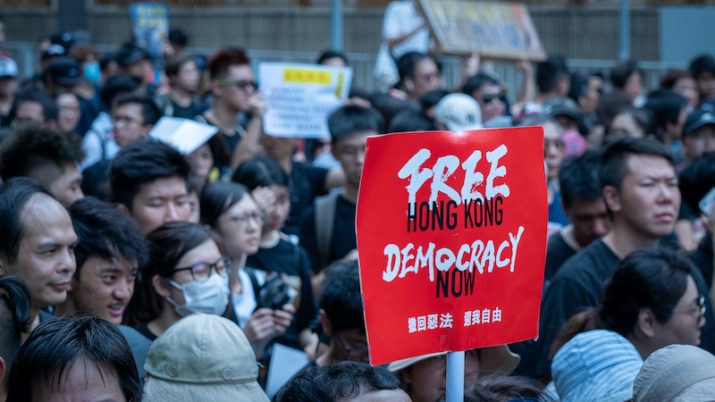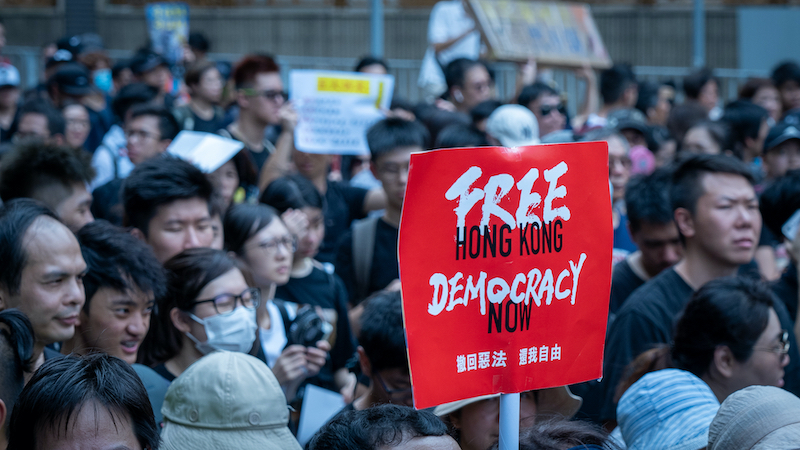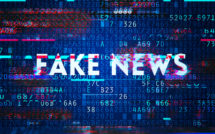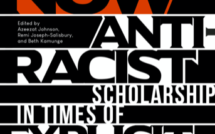

“Five demands, not one less” is a key slogan of the Hong Kong protests 2019, twelve years after the hand-over of the once Crown colony to the People’s Republic of China (PRC). Also beyond the withdrawal of the infamous Extradition Bill, protesters demand amnesty for all political prisoners who were arrested and sentenced in the course of the protests. They insist on not classifying the protests as “riots,” and request an independent investigation of police violence against protesters, journalists, and bystanders. Finally, they demand the introduction of universal suffrage, a fundamental democratic right, which also the former European colonizers had never granted the Hong Kong populace. The tragedy of the colonial discourse with its repeated but never fulfilled promise of enlightened self-determination in Europe’s colonies—an ambivalence also well captured in the catchphrase “almost, but not quite”[1]— indeed repeats itself as farce in postcolonial Hong Kong.
Since spring 2019, the postcolonial metropole has experienced mass protests with initially up to two million demonstrators. Yet, over the summer 2019, the conflict intensified: the protests caused enormous property damage, the police shot about 10,000 teargas grenades and incarcerated over 5,000 people, multitudinous people were injured—both police and protesters, of whom at least three were shot by the police with lethal rounds. At least nine people committed suicide, leaving notes in support of the protests, and on November 8th, Chow Tsz-lok, according to protesters embattled by riot police and tear gas, fell from a parking deck and subsequently died in the hospital. Hong Kong has received worldwide media coverage, ranging from unconditional solidarity in Cantonese diasporas and among lawmakers in Western democracies—especially in the US, but to a lesser extent also in the EU—to outright demonization of the protests by the PRC as anti-Chinese terrorism. As unequal as the different politically motivated reporting is: they are united in marginalizing or even silencing Hong Kong’s colonial history, and the entanglements and ramifications of particularly European and Japanese colonial rule and imperial legacy in the Hong Kong protests are just a mere footnote. Here, on the contrary, I argue that the Hong Kong protests are not only engrained in European ideals of capitalist democracy, but that they also permute aspects of Europe’s other former key global exports—colonialism and imperialism—in their struggle for democratic rights.
Already in the very beginning of the large protest marches in June 2019, a participating unnamed Hong Kong anarchist collective had criticized that the protest contains strong nationalist tendencies. Although the protests are too heterogenous to be called a movement, the common aim of the withdrawal of the Extradition Bill, the outrage about police brutality, and the critique against the incompetence and strong pro-Beijing ties of the Hong Kong government nevertheless created an overall solidarity. Yet, this momentous collaboration hides the fact that much of the force behind it is generated by people from the middle class who are eager to protect their privileges and property. This would also explain why there is no wholehearted support for the protest from the working classes. Furthermore, there hasn’t been an overall critique of the unequal present conditions—the modes of production and distribution of wealth in Hong Kong. The protesters rather reproduce the image of a threatening scenario, in which China’s Communist Party will undermine and eventually destroy Hong Kong’s capitalist, allegedly liberal-democratic order with rigid control or even expropriation.[2] And it is exactly the logic of this scenario, which has been the foundation of Hong Kong’s national myth in the European and diasporic Chinese imagination of Hong Kong as an island of wealth, freedom and the rule of law—almost as a negation of mainland China. Yet it was China, from where most present Hong Kong citizens (or their ancestors) have migrated to Hong Kong at different times in history, very often during conflicts with European and Japanese imperial powers: after the Opium Wars, the Second Sino-Japanese War, the Chinese Civil War, but also during the Cultural Revolution. The geographic and cultural proximity of Hong Kong, and in particular the framework of British colonial rule provided for successful migration. Life in Hong Kong might not have offered political participation, but it fostered economic and social mobility, secured wealth and property, and facilitated integration into the world system under European imperialist tutelage.[3] The prevalent nationalism in the Hong Kong protests and the protection of certain privileges can thus not be detached from Hong Kong’s colonial past and the legacy of European imperialism.
There are many good reasons to criticize Hong Kong and China’s leadership—we might even consider it necessary in light of increasing surveillance and restrictions of democratic rights. The demand for universal suffrage is also legitimate. In colonial Hong Kong, the British Crown in London dispatched the governor, who appointed all official and unofficial members of the Executive Council as well as the members of the Legislative Council (short LegCo). Today, quite similar, the State Council of the People’s Republic of China appoints Hong Kong’s Chief Executive, currently Carry Lam Cheng Yuet-ngor, after 1,200 delegates (all also PRC State Council appointees) have elected the Chief Executive candidate in a nonbinding election. The Chief Executive still appoints members of the Executive Council, and only half of LegCo’s seats are dedicated to public election; the other half is reserved for “functional constituencies,” representatives of the major commercial, industrial and financial sectors. In this regard, a commentator who just goes with the name Tony, recalls colonial Hong Kong’s structural injustices that are also inherent to the electoral system. Elucidating on the multiple meanings of “liberate” in Cantonese (光復) as used in the protest slogan “Liberate Hong Kong” which also include “restore”, Tony rhetorically asks to the point: “What do we want to restore? (…) No matter how dark Hong Kong’s reality gets, there is no need for us to romanticize our colonial past.”[4]
Unfortunately, protestors’ demand for universal suffrage, political participation and the critique against China’s political and economic mingling in Hong Kong affairs loses its strength if it exhausts in slogans such as “Chinazi” or “Capitalism is Shit – CCP is Capitalist.” These slogans just become empty signifiers in an injudicious semantic game. And they entail dangerous action as they spur xenophobic violence. For instance, some protesters attacked branches of banks and companies because they are run by mainland Chinese in Hong Kong, including Bank of China (Hong Kong), Best Mart 360 and Yoshinoya. They also attacked shops with Cantonese ownership, such as Maxim’s or the subway company MTR, after the companies’ management expressed sympathy with China or antipathy with the protests. And on several occasions mainland Chinese and local Cantonese were attacking each other in ordinary neighborhoods with fists, sticks, iron bars, knifes, and fire accelerants.
Due to unclear naming of the key issues, the Hong Kong protests miss the chance to articulate and practice a principled analysis and critique of Hong Kong’s ruling conditions. Particularly the younger generation would have every reason to do so: the highly competitive educational system, increasing tensions in the job market as well as the foreseeable end of the “one system, two countries” regulation in 2047 offer no bright future perspectives. The majority of young people will most likely make no pathbreaking career, experience no social mobility, and are not granted political emancipation. Hong Kong’s real estate economy, one of the most expensive in the world, for instance, often does not even allow young employees with good salaries to move out of their parents’ house, let alone start a family in their own home. Hence, the promises of the liberal-democratic capitalist system for a life of security, prosperity and freedom can never be fulfilled in young Hongkongeses’ everyday life worlds.
Since the early summer of 2019, protesters started to ask the EU, but especially the UK and the US for help and support, targeting particularly those countries that at least used to be the self-proclaimed leaders of the “free world.” The European Parliament as well as lawmakers in various European countries demanded deascalating the violent protests, and many of them expressed their concern about police violence and the threat to human rights and the rule of law in Hong Kong. Yet, the EU’s concern about threatening its economic relations to China apparently outweighs their promotion of democracy and human rights, and thus neither the EU or any European country alone took any serious diplomatic actions against the PRC.[5] In Hong Kong, meanwhile, protesters increasingly used Hong Kong’s colonial flag and foreign national flags during their demonstrations to further convey their request for international support, as symbols of European and American democratic values, and probably also as means to provoke China. This phenomenon itself probably does not qualify to make an argument for the connections between the protests and Hong Kong’s colonial past. But, Hong Kong’s colonial flag and the Union Jack, obviously, but also Stars & Stripes and Hi no maru, the flags of the US and Japan respectively, do refer to relationships of imperial histories, particularly in the context of Hong Kong. And being interwoven into a net of signifying symbols and performances highlights this observation. For example, on November 8thstudents commemorated the death of Chow Tsz-lok and played “Last Post,” a song from the nineteenth century British Empire that has been used also in the Commonwealth during military funerals—and in particular to honor soldiers killed in action. “Last Post” therefore orchestrates a direct relation to an imperial tradition, of which Hong Kong used to be an integral part. Moreover, commemorating students using “Last Post” also perform a male dominated, martial character of the protests that constructs especially the “front-liners” (those fighting in the first rows in direct physical contact with the police) as hypermasculine soldiers on the battlefield.
Stars & Stripes and the involvement of the US in the Hong Kong protests hint at imperial contexts of the twentieth century. In light of the ongoing US-China trade war it is probably no surprise that protest poster boy Joshua Wong Chi-fung is meeting European and American ministers/secretaries and lawmakers to ask for their support. However, it is important to note that Wong—either consciously or unknowingly—is able to draw on a well-established tradition of anti-Chinese, or more precisely: anti-PRC politics in Washington DC. Among others, Wong repeatedly met US Senator Marco Rubio, who is currently co-chairing the Congressional-Executive Commission on China and is a member of the Subcommittee on East Asia, The Pacific, and International Cybersecurity Policy. Rubio sponsored the Hong Kong Human Rights and Democray Act, which both House and Senate have passed unanimously and thus indicates—contrary to EU foreign policy—a much stronger US engagement in Hong Kong’s pro-democracy movement. Simultaneously, Rubio keeps close ties to the National Endowment for Democracy (NED), which, founded in 1983, became famous for its notorious planning and financing of regime changes and the enforcement of US hegemony during the later years of the Cold War and beyond—also in the Asia Pacific. Of course, connecting such narratives can easily drift into mere conspiracy theories, yet the NED has according to its own public statistics invested over 29 million US dollars into various pro-democracy groups and organizations in Hong Kong. Among them is media tycoon Jimmy Lai, a friend of the late Milton Friedman and with close ties to the US administration, whose newspaper Apple Daily hit the headlines when depicting mainland Chinese in Hong Kong as locusts in 2012.[6] At this point, however, it is important to keep in mind that Lai’s media, Wong’s party Demosistō, nor any other pro-democracy parties and civil society organizations can claim leadership or even authority about the protests’ meaning and direction. The protests remain organized in a decentral fashion, often by applying social media and chat groups, which is also significant for the following discussion.
Because, then there is Pepe the Frog! Pepe emerged 2005 as an apolitical cartoon figure in the American comic zine Boy’s Club, but became famous later as meme, that increasingly popularized since 2016 as an important character of the Alt-Right movement and circulated widely among right-wing populist and extremist groups. In the US, Pepe is seen as a symbol of white supremacy, and the Anti-Defamation League categorized Pepe as a symbol of hate speech due to the way it has been utilized. The various possibilities to design Pepe, in addition to the easy means of distributing the meme through social media channels, are probably the main reasons for Pepe’s fame in the Hong Kong protests. Apparently, many users in Hong Kong are not aware of Pepe’s career in the Alt-Right. And others do not care, or they argue that Pepe has lost its Alt-Right meaning in Hong Kong. In support of their argument, some protesters refer to the protest slogan “Be water, my friend,” a phrase coined by Bruce Lee, which is meant to express the fluidity and multitude of meaning of the very heterogenous Hong Kong protests.[7]
Despite my deepest sympathy with practices of appropriation (Aneignung), reinterpretation, and ambiguity (Mehrdeutigkeit): the choice of Pepe as key character in the Hong Kong protests is at best unfortunate. Because also in this case Hong Kong’s imperial past matters. Pepe in relation to the Hong Kong protests can not only be observed in Hong Kong proper, but also in Japan, or to be more specific: at Tokyo’s Meiji Shrine (Meiji Jingū). The Meiji Shrine, built 1920 in commemoration of Emperor Meiji, that has always been a “symbolic center for the religious expression of national sentiment,” was and still is also a center in Japan’s nationalist and imperialist shrine system.[8] Now, at the shrine, Hong Kong tourists have written their wish of liberating Hong Kong on small wooden votive tablets called ema (literally “picture-horse”)—together with a drawing of Pepe. Ema are commonly used in Japan to communicate a wish to the gods (kami), and hung at a specific spot at the shrine, visible for priests and other visitors, before they are burned in a ritual fire. Thereby ema serve the double function of articulating a wish for “earthly benefits” (genze riyaku) to the gods as well as communicating it publicly to priests and the community.[9]
To put it mildly, calling for Hong Kong’s liberation through Japan at Meiji Shrine bears a certain irony. Japanese ideologues had already stylized themselves once as Asia’s saviors from European colonialism in the early twentieth century, in which Shinto played not an unimportant role. Shinto shrines and rites helped to construct and imagine a national unity. In the Japanese empire Shinto shrines were an integral part of imperial assimilation policies to rule colonial societies through their integration in Shinto rites and festivals. Interpretations of State Shinto were also a major component of imperial Japan’s pan-Asian ideology that was meant to legitimate Japan’s imperial expansion and promised the people of Asia liberation from Western colonialism under Japanese leadership. Japanese ideologues called it the Greater East Asia Co-Prosperity Sphere (daitōa kyōeiken), which encompassed Hong Kong. In December 1941 the Japanese Imperial Army had occupied Hong Kong for “three years and eight months” (三年零八個月), an expression that has become a metonym of the occupation period and is still in use today. The imperial Japanese occupiers ruled Hong Kong under martial law, and they extremely restricted politics, administration, public health, education as well as public life in general. They maintained policies of racial segregation, incarcerated British soldiers and civilians, and also committed massacres in the Hong Kong population.[10] Liberation is different. Hence, in light of Japan’s aggression in World War II and Japan’s “merciless,” even “total” war with mass killings, forced labor and sexual slavery, which was especially rampant in China, wishing for Hong Kong’s liberation through Japan is not just unfortunate.[11] It is tasteless, historically blind, and politically dangerous. In particular in regard to Pepe’s Alt-Right baggage and the well-established extreme right-wing Japanese nationalists still fantasizing about Japan’s past and future imperial might at Shinto shrines, Pepe’s presence on ema at the Meiji Shrine does play into the hands of rightist propaganda.
This commentary is not intended as culture pessimist plea for youths’ lack of historical knowledge, nor does it claim to provide a thorough analysis of the Hong Kong protests. It is merely meant to point out some facets in the Hong Kong protests that relate to Hong Kong’s colonial past and that are interwoven with longer European, American and Japanese imperial histories also beyond a simple Hong Kong vs. PRC antagonism. Yet the protesters in Hong Kong should be aware about how and to which histories they connect their protest practices, and which images they want to generate and reproduce. Or, addressing the bigger picture: which form of social organization do they envision, and who should, is able and allowed to participate in it? Such issues are not limited to post-imperial spaces such as Hong Kong, but also of concern for participating and uninvolved observers, including Europeans and Europeanists. In light of current phenomena such as the gilets jaunes in France, rising right-wing populism and nationalism all over Europe and social media undermining democratic discourse and the electoral system, the Hong Kong protests raise important questions also for a European audience. Acknowledging and analyzing them help us better understand current strategies and content of protests, formations of social movements, meanings of political participation and emancipation, and dangers to democracy.
Robert Kramm holds a doctoral degree in history from ETH Zurich and was a post-doctoral fellow in the Society of Fellows in the Humanities at the University of Hong Kong. Since January 2020, Robert Kramm is appointed Freigeist-Fellow of the Volkswagen-Foundation and leads a research group on “Radical Utopian Communities: Global Histories from the Margins, 1900-1950” at the Department of History, LMU Munich. His field is global history of the 19th and 20th-centuries with a combined focus on modern East Asia/Japan, cultural history, and the history of everyday life. His first book, Sanitized Sex: Regulating Prostitution, Venereal Disease, and Intimacy during the Occupation of Japan, 1945-1952, was published 2017 with University of California Press, and he co-edited the volume Global Anti-Vice Activism: Fighting Drinks, Drugs, and ‘Immorality’ (Cambridge University Press, 2016).
[1] Homi K. Bhabha, The Location of Culture (New York: Routledge, 1994), 123.
[2] The anonymous interview can be read here: https://crimethinc.com/2019/06/22/hong-kong-anarchists-in-the-resistance-to-the-extradition-bill-an-interview (accessed: 8 Nov. 2019, 15:25).
[3] John M. Carroll, A Concise History of Hong Kong (Lanham: Rowman & Littlefield, 2007), 3-4.
[4] The original comment in Cantonese was published on 27 July 2019: http://theowl.hk/2019/07/24/%E6%B2%92%E6%9C%89%E5%85%89%E5%BE%A9-tony/?fbclid=IwAR04u3Anqa7bdcX7_Ygzdwy7hguYPByS39BZSeMjCQVTaPgV0k8ljctO-VA (accessed: 14 November 2019, 9:31), and an English translation can be found here: https://lausan.hk/2019/this-is-not-restoration/ (accessed: 14 November 2019, 9:35).
[5] Keegan Elmer, “Europe reluctant to do more about Hong Kong for fear of Beijing’s reaction, say diplomats,” South China Morning Post, 20 November 2019.
[6] See for example the article published by the not unproblematic MintPress News: https://www.mintpressnews.com/hong-kong-protest-united-states-destabilize-china/261712/ (accessed: 10 November 2019, 13:31); equally suspicious of reproducing conspiracy theory are the evaluation by Popular Resistance: https://popularresistance.org/we-are-not-fooled-by-the-hong-kong-protests/ (accessed: 11 November 2019, 21:20).
[7] Christina Ko, “How Pepe the Frog became face of Hong Kong protests – despite cartoon being a symbol of hate in US,” South China Morning Post, 17 August 2019.
[8] Helen Hardacre, ”Meiji Shrine,“ in Modern Japan: An Encyclopedia of History, Culture, and Nationalism, ed. by James L. Huffman (New York: Routledge, 2013), 151-152.
[9] Jennifer Robertson, “Ema-gined Community: Votive Tablets (ema) and Strategic Ambivalence in Wartime Japan,” Asian Ethnology 67, Nr. 1 (2008): 43-77.
[10] Carroll, A Concise History of Hong Kong, 123.
[11] The terms “merciless” and “total” war are borrowed from John Dower, War without Mercy: Race and Power in the Pacific War (New York: Pantheon Books, 1985) and Benjamin Uchiyama, Japan’s Carnival War: Mass Culture on the Home Front, 1937-1945 (Cambridge: Cambridge University Press, 2018).
Photo: Hongkongers march in Sha Tin against Hong Kong’s extradition bill, unprecedented violence by riot police pepper sprayed protesters | Shutterstock
Published on January 16, 2020.




